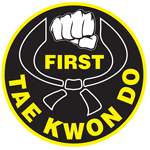First Taekwondo Hyung and Kup System – Its Meaning and Origin
There are altogether six colours and ten KUP (grades) with nine DANS (degrees) in the TI (belt) system.
The counting of ranks starts from 10th (beginner) to 1st and from then on the black belts begins from 1st to 9th Dan. There are six colours used to denote a specific rank in the Ti system. Those colours are White (10th & 9th grades), Yellow (8th & 7th grades), Green (6th & 5th grades), Blue (4th & 3rd grades), Brown (2nd & 1st grades) and finally Black (1st to 9th Dan).
The choosing of these six colours is by no means accidental; in fact they bare traditional values, which date back to the Silla Dynasty approximately 1300 years ago. The colours indicate the different levels of hierarchy within the Dynasty at that time. Therefore the progression of skills and development of the understanding in the art itself by the practitioner is reflected in the different stages of training attainment of the colour symbolism hierarchy.
There is significant meaning in the nineteen ranks of the system, being 10th Kup at the beginning, which is the lowest rank, through to the 9th Dan, being the highest rank and considered the ultimate.
Why 9th and not 10th Dan?
In the Orient the symbol of numbers are taken seriously, what they represent and how they mysteriously affect lives and events around us. In Chinese the number 3 is looked upon favourably. With a slight twist of the tongue the pronunciation of 3 indicates life or growth. The number 3 therefore is a highly regarded number with certain connotations.
The character 3 written in Chinese is

It symbolises heaven, mortals and earth accordingly from top to bottom of the lines.
The character representing King is

It symbolises the country, fellow man and God. For the individual to be successful in promoting all three he would aspire to become King. These two characters are nearly synonymous. Therefore if three multiplied by three equals nine and at the same time nine is the highest of all single digit numbers, this then indicates the highest of the high among the Black Belts.
Hyung (patterns or forms) are an important part of the art. They provide the ultimate discipline of mind and body of the practitioner. A Hyung consists of various combinations of basic techniques into systematic and logical movements of attacking, defending, jumping, gliding and so on, to an imaginary opponent. The design of the Hyung is to eventually enable the student to perform with grace and rhythm, while at the same time with power, speed, balance, control of body and mind, and efficient breathing. This ultimate achievement is only possible after hours of consistent training. Hopefully the mastery of Hyung enables the practitioner to sharpen all aspects of the techniques, understand the flow of energy in the body, and develop a strong and guided mental aspect in character building. All these acquired aspects will lead to an impenetrable spirit and develop a strong sense of singleness of purpose to combat problems and the pressures of life.
The development of Hyung figures prominently in the history and culture of Korea. The art itself emphasises heavily on aspects of spiritual, moral and physical development. Thus these values are demonstrated in different Hyung. Initially monks first started to practice the art (Tae Kyon) in the northern provinces of Korea during the fourth century. Only in the seventh century was the art taught to the general community. There were three kingdoms then and they were at war. The Silla kingdom survived. During that time a band of monks calling themselves Hwa Rang Do emerged and were known for their fighting skills. The kingdom of Silla was eventually overthrown in AD935 and the kingdom of Koryo (Korea as known today) was established. After the decline of the Koryo Dynasty the practice of the art went with it. During the Japanese occupation Tae Kyon was completely banned, except in remote rural areas. After the end of World War II, the feelings of patriotism and national pride not only revived the art but also refined the art to suit the modern day requirements, the rest is history.
Today’s Hyung depict significant historical events and characters of the past through the long and rough evolvement.




